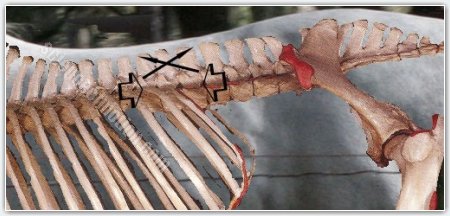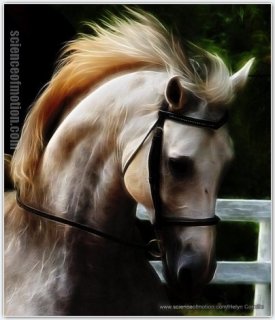Gravity
Gravity
By
Jean Luc Cornille

"The major problem that the horse has. The major problem that all terrestrial animals have. The major work that they do throughout their lives is resisting gravity. Resisting the accelerations of gravity which tend to drive them down to earth.'" (James R. Rooney, 1971)
And the pathologist explains how the fascicles of the main back muscles, the multifidus, are oriented oblique down and back, while those of the longissimus dorsi are oriented oblique down and forward. Their coordinated action creates vertical forces that cancel the attraction of gravity.
Basically and very schematically, the fascicles of the main back muscles are oriented, as illustrated in this picture with the two black arrows. The angle of the fascicles allows for the creation of horizontal forces and presses the vertebrae against each other, which results in the greater transmission of horizontal forces, i.e., "forward movement." The angle of the fascicles also permits the creation of upward forces resisting the attraction of gravity and facilitating "balance control."
Gravity is always pulling the horse's thoracolumbar spine down to earth. Richard Tucker, who in 1964 authored the first dynamic study of the equine vertebral column, explained that while one side of the body is supported by the foreleg in the stance phase (upward thrust), the other side is pulled down by the attraction of gravity, (downward thrust). "Rotary forces are always complicated by the existence of transversal forces which result in a downward thrust on any particle situated on one side of the section and an upward thrust on particles situated on the other side." Richard Tucker, Biomechanical characteristics of the Thoraco-lumbar Curvature. Vol VIII, 3: 45-72. BIALOWIEZA. 15. X. 1964"
Anyone following our discussions knows that lateral bending of the equine thoracolumbar spine is always coupled with transversal rotation movement. Even if initiated in the thoracic vertebrae, transversal rotations involve the ribs, the sternum, and the muscular system supporting the trunk between the forelegs. The claim that muscular or myofascial release can enhance lateral bending is from la-la land where gravity is nonexistent. Whenever the horse's thoracolumbar column is bend right or left, the muscular system has to resist gravity, and gravity is not resisted releasing or even reducing muscle tone. The thoracolumbar spine bends laterally right and left in synchronization with limb movements at the walk and the trot. Lateral bending occurs mainly between T9 and T16, but there is also a small capacity of lateroflexion between L1 and L5. Transversal rotations occur mainly between T9 and T14. Lateral bending is not achieved by contracting one side and releasing the other side. This is a very naïve claim. Lateroflexion and associated rotation are the outcome of a complex orchestration of force production, and therefore muscular work dealing with many components and is created while resisting gravity.
"The reflex contractions of the spinal column muscles compensate for the bending of the spinal column. This is a characteristic behavior of the spine stabilizing system during human movement. As a result, even small compensatory difference between the right and left side causes permanent asymmetric, dynamic overloading of the soft tissue." (Ober J. K. 1974, A dynamic concept for the diagnosis of idiopathic scoliosis. In; Biomechanics IV. Proceeding of the 4th International Seminar of Biomechanics. Eds R. C. Nelson & C. A. Moorhouse, Macmillan Press Ltd, London & Basingstoke.) This is the fundamental principle of spine stability. For any muscular work bending the thoracic spine, there is a compensatory contraction stabilizing the structure.
Lateral bending is always coupled with a transversal rotation shifting the dorsal spines toward the inside of the bend. The ribs are attached to the vertebral bodies via two heads. Therefore, even if axial rotation is initiated in the thoracic vertebrae, it induces a pendular movement of the ribs and sternum, demanding work of the muscular system supporting the trunk between the forelegs. This muscular system induces a lift associated with each rotation. This is partially due to the attachment of the main pectoral muscles situated around the elbow and, therefore, higher than their insertion on the sternum. A great part of this muscular work is resisting accelerations that are produced when the effect of gravity is accelerated by other forces such as inertia. One can now understand why releasing pectoral muscles would be detrimental to the horse locomotion. A significant part of the protraction of the limbs is the elastic recoil of energy stored in the tendons and aponeurosis during the stance phase. This elastic strain energy is enhanced by the resistance of the correspondent muscles. The capacity of storing elastic strain energy in the tendons and aponeurosis is hampered when the correspondent muscles are underdeveloped or released.
The work of the muscular system is incredibly sophisticated and complex. This work is more likely disrupted by local or overall muscle release than it is enhanced. There is no question that myofascial release or other therapies are useful in case of strain, spasm, or other similar issues. What is misuse is when therapies are used to cover trainers' incompetence. An overall release of the muscle tone might minimize the horse's resistance when asked to perform lateral bending, half pass, or other movements without adequate muscular development and coordination. The cover-up serves the rider but exposes the horse to instability, dysfunction, and consequently lameness. The value of a training approach is precisely its ability to develop and efficiently coordinate the horse's physique for the athletic demand of the performance. As long as we look at muscles as moving bones through shortening or lengthening, we have a superficial perception that can be satisfied by theories that feel-good generalities with no basis in reality. Once we start to understand the complexity of the muscular work, we develop a totally different picture in our brain and, thus, a much more sophisticated perspective.
During a previous discussion about the psoas, we have briefly referred to the elastic energy stored in the aponeurosis of the tensor fascia lata and how this elastic strain energy was a significant part of the mechanism swinging the hind leg forward. Since today we are on the forelegs, a brief explanation of the catapult mechanism of the biceps brachii might help us understand why simplistic theories such as touching the limbs with a whip or releasing muscles before work is feeding our fantasies but failing the horses. The fibers of the biceps brachii are short and have little scope for length change. The muscle fibers can only shorten slowly and, therefore, cannot create the rapid limb protraction demanded during the swing phase at the trot or the canter. The biceps do have a thick internal tendon that stores elastic strain energy during the stance. The energy stored in the internal tendon is then rapidly released as soon as the hoof clears the ground catapulting the front limb forward into the swing phase. The muscle fibers alone are too slow for the rapidness of the limb protraction. This ingenious mechanism is referred to as a "catapult mechanism." The contractile elements of the biceps, the muscle cells or fibers, and the internal tendon are referred to as a muscle-tendon unit (MTU). During the stance phase, the biceps' short fibers modulate the amount of energy stored in the internal tendon. "The modulation of elastic energy stored and returned by biceps is important for changes in everyday movement patterns; for example, the sum of the potential and kinetic energy required for protraction of the limb during the entire swing phase of trot is approximately only 30% of that required in gallop". (Wilson et al., 2003) The contractile elements of the biceps, the fibers, have the capacity to modulate the tension of the internal tendon to match the demands of each gait, the transitions from one gait to the other, and the variables within each gait. The nervous system changes the number and distribution of muscle fibers activated in order to create a tension of the internal tendon appropriate for the swing and, therefore, the next stride. As we ask a down transition canter to trot, the horse's brain activates the number and distribution of the muscle cells needed to create a tension of the internal tendon appropriate for the upcoming swing, which demands 30% less energy at the trot than at the canter. This is why I always teach, when you are working a transition, for example, canter to trot or trot to walk if you think about improving the walk once the horse has completed the transition, your horse's brain is ahead of yours. If you want to be effective, coordinate your body for the walk before the horse even walks.
The horse's physique is a piece of art. It deserves respect and knowledge. It is insulting for such a sophisticated biological mechanism to be treated with primitive theories such as the one rein stop, the whip on the limbs, the relaxation theories, and so on.  The horse's physique is a masterpiece that deserves true masters. A true master does not live in the past. A true master is you, competitive rider, classical rider, backyard rider, or therapist who respects the horse enough to upgrade your education to actual knowledge of the equine locomotor mechanism. It is for you that we have created the IHTC.
The horse's physique is a masterpiece that deserves true masters. A true master does not live in the past. A true master is you, competitive rider, classical rider, backyard rider, or therapist who respects the horse enough to upgrade your education to actual knowledge of the equine locomotor mechanism. It is for you that we have created the IHTC.
Jean Luc
12/18/14


